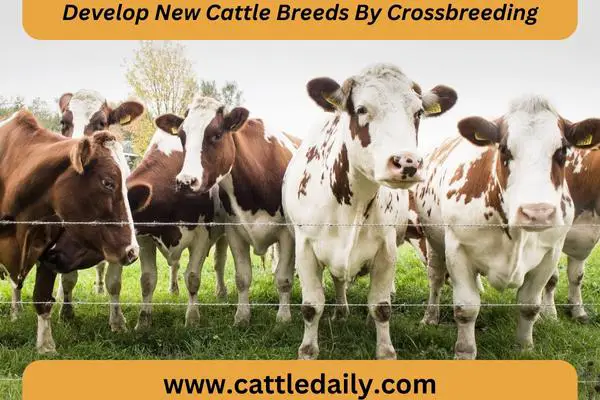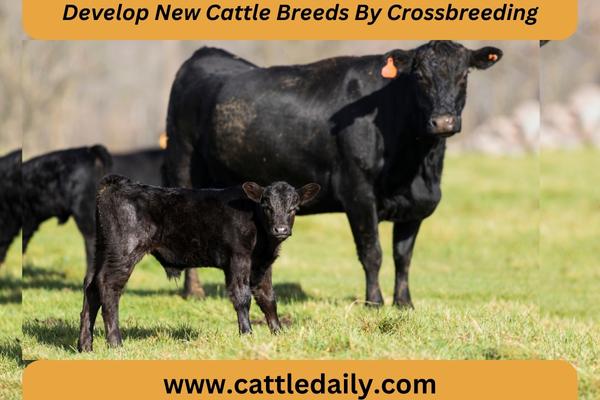Develop New Cattle Breeds By Crossbreeding
The global demand for quality beef is rising, and cattle producers are looking for ways to improve productivity and efficiency. One method for developing cattle with enhanced traits is crossbreeding – combining the desirable qualities of two or more cattle breeds into one animal.
Crossbreeding allows cattle producers to take advantage of breed differences and heterosis while managing unwanted traits.
In this blog article, we will examine the benefits of crossbreeding cattle, considerations for choosing parent breeds, the crossbreeding systems used in the cattle industry, and advice for developing a successful crossbreeding program.
Implementing an effective breeding strategy can help cattle producers select for optimum performance in their herd.
Benefits of Crossbreeding Cattle
Crossbreeding offers commercial beef producers several advantages compared to using only straight-breed animals. Some key benefits include:
1. Heterosis – Crossbred animals exhibit hybrid vigor or heterosis, which is the increased performance for traits like growth rate, fertility, and longevity compared to purebred animals.
The heterosis effect results from the increase in heterozygosity or genetic diversity from combining divergent breeds. Heterosis levels are highest in first-cross animals (the initial cross between two pure breeds.
2. Complementarity – An additional advantage of crossbreeding is combining the strengths of two or more breeds to produce an animal with the ideal blend of traits.
For example, crossing a breed known for high intramuscular fat and marbling, like Angus, with a lean breed that excels in meat yield and growth, like Charolais, can result in an animal with both good marbling and leanness.
3. Breed Complementation – Crossbred animals also benefit from breed complementation. This occurs when the strengths in one breed offset or complement the weaknesses in the other breed. For example, British maternal breeds tend to be lower in milk production but exhibit excellent maternal behavior.
When crossed with a Continental breed that produces more milk but shows poorer maternal traits, the resulting offspring will benefit from the breed complementation.
4. Increased Genetic Variation – Introducing two or more breeds through systematic crossbreeding boosts the genetic diversity within a herd compared to using animals of only one breed.
This increased heterogeneity gives producers more options for matching cattle genetic types to their specific production environment and resources.

Choosing Parent Breeds for Cattle Crossbreeding
When designing a crossbreeding system, breed selection is critical. Consider the following factors when choosing breeds:
- Production Environment – Match breeds to your region’s climate, terrain, feed resources, and overall management system. For instance, Bos indicus breeds with heat tolerance, insect resistance, and adaptability excel in hot, tropical regions while hardy British and Continental breeds suit cooler northern climates.
- Market Specifications – Select breeds that can produce calves meeting current consumer preferences and market specifications for traits like intramuscular fat, tenderness, carcass leanness, or target body size.
- Maternal Traits – For the female side, use breeds with excellent maternal ability, including fertility, milk production, mothering instinct, and calf survivability. Well-regarded maternal breeds include Angus, Hereford, Red Angus, Gelbvieh, and some Continental breeds.
- Growth and Carcass Traits – For the sire side, focus on terminal sire breeds offering superior growth performance, feed efficiency, and carcass cutability and quality. Prime examples include Charolais, Limousin, Simmental, and other Continental breeds.
- Complementarity – Finally, choose parental breeds exhibiting complementarity. For instance, breed for greater milk production capacity in the female and rapid lean growth in the male. This allows for matching complementary strengths.
By strategically selecting breeds, cattlemen can produce animals tailored to their environment and market goals.

Crossbreeding Systems
Several crossbreeding systems allow producers to take advantage of heterosis and breed complementarity. Common methods include:
- Two-Breed Rotation – In this system, producers alternate between two breeds. For example, they may breed Angus cows to Hereford bulls, then breed Hereford-Angus cross cows to Angus bulls.
- Three-Breed Rotation – This program uses three breeds in rotation. For instance, the breeds could be Angus, Hereford, and Simmental.
- Rotational Terminal Cross – Dams of another breed are bred to terminal sires of a third breed. The females only are kept as replacements.
- Composite Breeds – New breeds are created by crossbreeding two or more established breeds. This combines breeds into one stable crossbred animal.
No single system is best for all operations. Producers should choose a sustainable crossbreeding method matched to their resources and goals.
Tips for Crossbreeding Success
When developing a new cattle breed via crossbreeding, the following tips can lead to better results:
- Test breed crosses on a small scale first to see if they perform as expected. Evaluate the animals closely for traits of economic importance.
- Use breeds that are compatible in terms of size, temperament and dairy character. Extreme differences between parent breeds can cause calving problems.
- Implement a breeding program that takes advantage of heterosis and avoids inbreeding through breed rotation.
- Carefully select breeding stock within each parental breed for optimum performance. Do not just use random animals.
- Cull cows and heifers that do not meet production targets for reproduction, growth, udder quality and other key traits.
- Keep detailed records to measure the performance of different breed crosses and guide future breeding decisions.
- Work with animal breeding specialists to develop a customized crossbreeding system for your herd and marketing goals.
Following a systematic breeding strategy will help cattle producers combine excellent traits from multiple breeds into a single, profitable animal.
Conclusion
Through strategic crossbreeding, cattle producers can unite the best qualities of two or more cattle breeds into one superior animal. Crossbred cattle benefit from heterosis, complementarity between breeds, and increased genetic diversity.
When developing a crossbreeding program, carefully choose compatible breeds matched to your environment and product goals. Follow a structured breeding system and cull animals not meet standards.
Effective crossbreeding enables commercial cattle operations to deliver high-quality beef products to consumers. With innovative breed combinations, the beef industry can continue improving the genetics of the global cattle herd.

